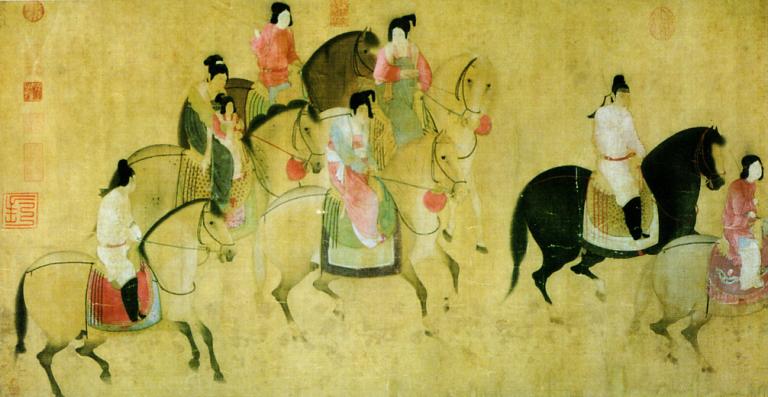Paintings in Sui and Tang Dynasties
5 min readThe period of Sui and Tang dynasties,especially Tang dynasty,was the most prosperous time in ancient China history.The society was comparatively stable;economy and culture were prosperous;Communication between China and other landsbecame more frequent.A1l had facilitated the comprehensive development and high achievement of the art of painting.

Figure Painting
At the time figure painting was of great importance in the art field.Buddhistpainting continued to develop until achieved the peak of development.The most important painters were all good at Buddhist painting,though the subject mattersand images of which were more into common customs.The paintings advocating self-surrender,self-sacrifice,karma and jakata stories of Buddha became less,yet illustrations for Buddhist sutra revealing luxury and conviviality became more.The characteristics of figures in painting also changed from being sublime and merciful to being gentle and amiable.For example,Bodhisattva was painted like palace child.Besides Buddhist subjects,figure paintings also made some achievements in revealin big political issues and development of national relations.For instance,Yan Liben painted The Eighteen Scholars in Qin’s Residence Family,Figures of MeritoriousOfficials in Lingyan Pavilion,Thirteen Emperors Scroll,Imperial Carriages,etc.
Life of the royal and noble families were also important subject in contemporary paintings.
Representative painters of figure painting in Tang dynasty include:Yan Liben(?-673),was born in a noble and painting family in Yongzhou,Wannian(Lintong,Shaanxi province).His father Yan Pi,who once worked as officials in Northern Zhou and Sui dynasties,was good at painting and knew well about architecture and craftwork.And Yan Lide,his brother,was accomplished in calligraphy and painting,architecture and craftwork as well.Besides painting,YanLiben also demonstrated his talent in politics.He had been the minister of Works and vice-premier.Yan Liben excelled in Buddhist and Taoist painting,figure painting,landscape painting and horse painting.His painted The Eighteen Scholars in Qin’s Family commemorating the 18 great scholars who served Emperor Taizong when he was the Prince of Qin and Figures of Meritorious Officials in Lingyan Pavilion to commemorate 24 of the greatest contributors to Emperor Taizong’s reign and all portraits were lifelike and vividly depicted.Yan’s works left till today include Thirteen Emperors Scroll and Imperial Carriages.The former includes 13 portraits of emperors from Han dynasty to Sui dynasty,aimed at providing reference for later emperors.The later depicts Emperor Tang Taizong receiving Ludongzan emissary of the Tubo(present Tibet)king Songtsan Gampo who married Princess Wencheng,which demonstrated the friendship between Hans and Tibetans in Chinese history.
Wu Daozi(c.686-760),also named Daoxuan,was from Yangdi(Yuzhou in Henan province today).He lost his parents when very young and lived a poor life since then.Yet he was determined in painting learning and had mastered high level of painting skills before he was twenty.In his early years he made a living as a folk painter.He once served as a military officer in Xiaqiu,Yanzhou.He also followedcalligrapher Zhang Xu and He Zhizhang to learn calligraphy before he focused on painting.He was especially good at Buddhist and Taoist painting.The figures,Buddhas,ghosts,immortals and animals all differentiate from each other yet al with accurate shape,vivid and lifelike images.His excellence in painting earned him the title as the Greatest Master of of Painting and the popularity of”Wu style design”.He also learned from Gu Kaizhi when he was young to use fluent fine lines in painting. After middle age, he used garment lines in a clear and determined way which endowed his painting with great vigor. He liked to use orchid-leave shaped and water-shield shaped strokes to depict his figures’ clothes as being in the wind. His artistic style was known as “flying clothes, flying murals”. He was also capable of using ink to sketch the form and adding light color to tinge the painting. This was known as “Wu Costume”as can be seen in his work Portrait of the Child-giving God (imitated in Song dynasty).

Zhang Xuan was from Jingzhao(Xi’ an in Shaanxi province). He once served in the court and was good at doing portrait of noble ladies. His figure paintings were always skillfully designed, for example, the vermilion used to tinge lady’s ear root and the childish looks and vivacity of expression found in baby paintings. Zhang was especially good at painting the nobles’ travelling and happy life, for instance, Spring outing of Madame Guo, and Court Ladies Preparing Newly-Woven Silk (imitated by Zhao Ji, Emperor Huizong of Song dynasty who reigned 1101-1124). The previous one depicts the spring outing of Madame Guo, sister of Yang Yuhuan who was the beloved concubine of Emperor Xuanzong in Tang dynasty. The splendid clothes and saddles were depicted as metaphor for the bright spring scenery, which was really fancy and full of imagination. Court Ladies Preparing Newly-Woven Silk depicts how the court ladies ironed the newly-woven silk and stitched them to make clothes. The painter caught the delicate change of people’s posture in the working process. The depiction of a little girl in the painting added more sense and vivacity of life.
Zhou Fang, with courtesy name Zhonglang, or Jing Xuan, was born in Jingzhao (Xi’ an in Shaanxi province) in a noble family. He had served as Sheriff of Yuezhouand Xuanzhou prefectures. He was accomplished in portraits and depiction of noble ladies. He first learned painting from Zhang Xuan and later formed his own style. Inhis figure painting, he used fine and smooth lines to do the sketch and used simple lines and soft color to depict the clothes. His paintings of court ladies were usually with “chubby cheek and plumy figure”, which became typical characteristics of lady figure painting in Tang dynasty. He also made achievement in Buddhist painting, depicting the sanctity and dignity of Avalokitesvara in a distinctly tranquil and clear environment, known as “Avalokitesvara as Moon in the Water”which earned him the reputation of “Zhou style design”. His works like Court Ladies Waving Their Fans and Court Ladies Adorning Their Hair with Flowers are incredible masterpieces that depict the bored life and emptiness of the court ladies.









